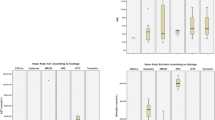Abstract
Background
Recessive LARS mutations were recently reported to cause a novel syndrome, infantile liver failure syndrome type 1 (ILFS1), in six Irish Travellers. We have since identified four additional patients, including one of Ashkenazi origin, representing the largest ILFS1 cohort to date. Our study aims to define the ILFS1 clinical phenotype to help guide diagnosis and patient management.
Methods
We clinically evaluated and reviewed the medical records of ten ILFS1 patients. Clinical features, histopathology and natural histories were compared and patient management strategies reviewed.
Results
Early failure to thrive, recurrent liver dysfunction, anemia, hypoalbuminemia and seizures were present in all patients. Most patients (90 %) had developmental delay. Encephalopathic episodes triggered by febrile illness have occurred in 80 % and were fatal in two children. Two patients are currently >28 years old and clinically well. Leucine supplementation had no appreciable impact on patient well-being. However, we suggest that the traditional management of reducing/stopping protein intake in patients with metabolic hepatopathies may not be appropriate for ILFS1. We currently recommend ensuring sufficient natural protein intake when unwell.
Conclusions
We report the first non-Irish ILFS1 patient, suggesting ILFS1 may be more extensive than anticipated. Low birth weight, early failure to thrive, anemia and hypoalbuminemia are amongst the first presenting features, with liver dysfunction before age 1. Episodic hepatic dysfunction is typically triggered by febrile illness, and becomes less severe with increasing age. While difficult to anticipate, two patients are currently >28 years old, suggesting that survival beyond childhood may be associated with a favourable long-term prognosis.




Similar content being viewed by others
References
All Ireland Traveller Health Study Team (2011) School of Public Health, Physiotherapy and Population Science, University College Dublin, Ireland. All Ireland Traveller Healthy Study. Our Geels
Casey JP, McGettigan P, Lynam-Lennon N et al (2012) Identification of a mutation in LARS as a novel cause of infantile hepatopathy. Mol Genet Metab 106(3):351–358
Chen Y, Klionsky DJ (2011) The regulation of autophagy – unanswered questions. J Cell Sci 124(Pt 2):161–170
Han JM, Jeong SJ, Park MC et al (2012) Leucyl-tRNA synthetase is an intracellular leucine sensor for the mTORC1-signaling pathway. Cell 149(2):410–424
Hutson SM, Stinson-Fisher C, Shiman R et al (1987) Regulation of albumin synthesis by hormones and amino acids in primary cultures of rat hepatocytes. Am J Physiol 252(3 Pt1):E291–E298
Jiang S, Yan C, Fang Q et al (2014) Fibroblast growth factor 21 is regulated by the IRE1α-XBP1 branch of the unfolded protein response and counteracts endoplasmic reticulum stress-induced hepatic statosis. J Biol Chem 298:29751–29765
Levine B, Yuan J (2006) Autophagy in cell death: an innocent convict? J Clin Invest 115(10):2679–2688
Murrow L, Debnath J (2013) Autophagy as a stress-response and quality-control mechanism: implications for cell injury and human disease. Annu Rev Pathol 8:105–137
Umemura A, Joong Park E, Taniguchi K et al (2014) Liver damage, inflammation, and enhanced tumorigenesis after persistent mTORC1 inhibition. Cell Metab 20(1):133–144
van Meel E, Wegner DJ, Cliften P et al (2013) Rare recessive loss-of-function methionyl-tRNA synthetase mutations presenting as a multi-organ phenotype. BMC Med Genet 14:106
Acknowledgments
We sincerely thank the patients and their families who have contributed to this study and helped our understanding of childhood liver disease. We would also like to thank Prof. David Wilson (Professor of Paediatric Gastroenterology and Nutrition at the University of Edinburgh) for his insightful discussions on albuminemia and amino acid homeostasis and Dr Seamus Hussey and Dr Annemarie Broderick for stimulating discussions on mechanisms of liver disease.
Funding
The genetic studies were supported by The Children's Fund for Health, Temple Street Children's University Hospital, Dublin, Ireland (PAC 09131). Jillian Casey is supported by a Medical Research Charities Group (MRCG) grant from the Health Research Board (HRB) and the Children’s Fund for Health, Temple Street Children’s University Hospital (MRCG/2013/02).
Compliance with Ethics Guidelines
ᅟ
Conflict of interest
None.
Author information
Authors and Affiliations
Corresponding author
Additional information
Communicated by: Johannes Häberle
Electronic supplementary material
Below is the link to the electronic supplementary material.
ESM 1
(DOCX 25 kb)
Rights and permissions
About this article
Cite this article
Casey, J.P., Slattery, S., Cotter, M. et al. Clinical and genetic characterisation of infantile liver failure syndrome type 1, due to recessive mutations in LARS. J Inherit Metab Dis 38, 1085–1092 (2015). https://doi.org/10.1007/s10545-015-9849-1
Received:
Revised:
Accepted:
Published:
Issue Date:
DOI: https://doi.org/10.1007/s10545-015-9849-1




